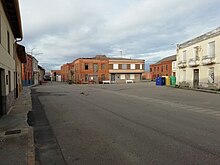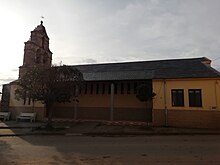Saint John of Torres
San Juan de Torres is a town in the municipality of Cebrones del Río, located in the south of the province of León, Spain. The municipality is made up of Cebrones del Río, San Martín de Torres and San Juan de Torres. They all belong to the region of La Bañeza.
The population of the City Council of Cebrones del Río, in 2020, is 439 people. And specifically, the town of San Juan de Torres has a population of 135 people.
Location
It is located southwest of the town hall at an altitude of 750 meters. In this town are the remains of an ancient Celtic fort located on top of a hill. It is a perfectly cataloged fort from the First Iron Age located in "La Cuesta" and that, judging by the remains, also from medieval times.
The town is crossed by the Órbigo river, a tributary of the Esla. land concentration.
In relation to its climate, it meets the characteristics of the province of León. During autumn there are rainy days that let in the cold winter air. Winter is cold and frosts at night are common. Then, with spring and its rains, they give way to a brief but intense summer in which temperatures of 35º can be recorded.
History
The town is also a passage through one of the old routes of the Vía de la Plata. Although this route is barely known to the locals, it is believed that it could be the original route, currently diverted for possible political and economic reasons.
Before, there was a path called Cañada, a pass for transhumants through which flocks of sheep circulated in the spring towards the mountains and returned to Castilla in winter, disappeared by the parcel; Only Calle Real remains within the town.
Like a Roman road, the route of the "Vía de la Plata" It enters the province of León from the El Tamaral area following the Camino Real or Cañada Real that passed through San Juan de Torres, to cross the Órbigo River over the La Vizana bridge. The route continues along the Camino Real Antiguo to La Nora. From Navianos it is considered a unique journey that is its passage through "Los Molinos" and "Los Villares" it was identified with the livestock route to San Juan de Torres.
If we refer to La Cañada as a cattle glen, leaving La Bañeza, it was identified with the "Camino de La Bañeza a San Juan de Torres", in such a way that the pre-Roman route was revitalized with the livestock traffic in that last section of Leon.
A few years ago there were two brotherhoods in the town, that of San Roque and San Antonio. Every year, three brotherhoods were chosen to bury the brothers who died that year in the cemetery. Every year those brothers would have a brotherhood meal at the house of one of them. In one of those meals around the time the civil war began, they bought the pasture of the Marquis of Castañón.
It is a town where in summer those who have a house return from where they are to spend a few days on vacation and thus remember and enjoy the extraordinary passages, having great relevance Calle Real that starts very close to the church and has a history of marquises because the Marquis de Castañon lived there.
The Marquises of Campo Fértil owned the so-called Paulón Bridge, over the Órbigo River and Venta Castañón, on the La Coruña road near the La Bañeza region. It is the Marqués de Castañón who buys a house with an inn, owned by the Marqués de Campo Fértil, located in the judicial district of La Bañeza between the municipalities of San Martín de Torres and Cebrones del Río. For this reason, part of the town was part of the marquisate.
Heritage
There was also a Romanesque church belonging to the Templars. It is the parish church of San Juan Bautista. The church was destroyed in the 1970s and all of its books, relics, saints and works of art were sold or disappeared. The current church is a simple and small church. Only the bell tower in the form of a belfry remains from the old one. The church tower has been restored, and the entrance to the church, the altar and the roof have been reformed, giving a touch up to the entire interior.
It has the Iron Bridge of the Vía through which the Órbigo river flows. Historic bridge due to its proximity to the old royal road from Madrid to Galicia. According to the plaque that appears on the bridge, it was built in 1935. On said plaque is engraved: "SM Duro - Felguera. The Felguera. Asturias. Year 1935".
The old royal road, is currently the national highway N-VI and A-6 (Autovía del Noroeste). Work began on this highway in 1993 when the section from the Valladolid town of Tordesillas was built to connect Madrid with Galicia.
Folklore
The town celebrates two festivities: on May 6 it celebrates San Mamés and on June 24, San Juan Bautista, its main and patron saint festival.
The folkloric demonstrations, bonfires and bowers, in the towns of the province of León, take place indistinctly on the nights of San Juan, San Pedro and San Pelayo, although they are reduced to the towns that have them as patrons. Although the most popular thing is to talk about the "night of San Juan" located from June 23 to 24, one can speak of the "San Juan cycle" which begins on the night of June 23 of the Gregorian calendar until the following seven days and closing with the celebration of Saint Peter the Apostle on June 29.
In the last century, in the Diocese of Astorga, within the towns that today form León, there were up to 27 churches dedicated to San Juan, one of them, that of San Juan de Torres.
The main act is the bonfire on the night of San Juan where notes of commensality are demonstrated among the neighbors. The people of the town gather around the fire to sing, dance, eat and drink in an attempt to strengthen neighborhood ties and strengthen their own ties of coexistence.
Contenido relacionado
Province of Heredia
Lubumbashi
Aldeadávila de la Ribera
Arakawa River
General Mosconi (Salta)




